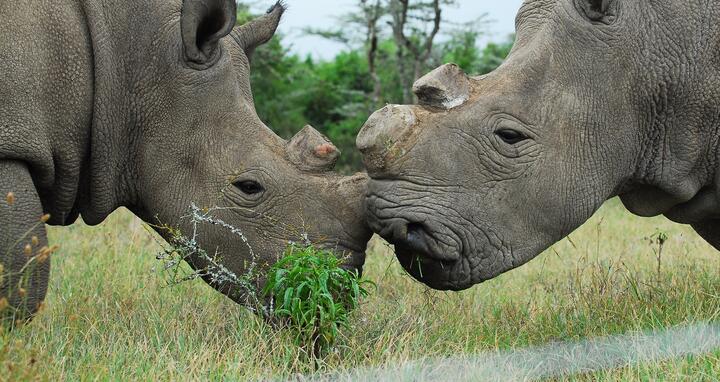Rhinos from skin cells
The last two northern white rhinos are females, currently living in the Ol Pejeta wildlife conservancy in Kenya where they are heavily guarded against poachers. Given that natural reproduction is no longer possible, the species is as good as extinct. A consortium of international scientists, including those from the Max Delbrück Center for Molecular Medicine (MDC) in Berlin, has now received four million euros from the German Federal Ministry of Education and Research to pursue a unique research strategy to try and save these magnificent mammals.
Combating extinction with assisted reproduction “BioRescue is a two-track concept,” says stem cell researcher Dr. Sebastian Diecke, head of the Pluripotent Stem Cells Platform at the MDC. The idea is to use artificial insemination to help the two remaining females to procreate. Professor Thomas Hildebrandt, the initiator of the project and head of the Reproduction Management Department at the Leibniz Institute for Zoo and Wildlife Research (IZW) in Berlin, wants to use a special device to take egg cells from the female rhinos. These eggs can then be fertilized in the laboratory with sperm that has been previously collected and deep frozen. The resulting embryos will be implanted into female southern white rhinos – a species that has around 21,000 individuals currently living in Africa.
Genetically, southern and northern white rhinos are very closely related. They are believed to have split off almost a million years ago and are now considered separate subspecies. “That's why we believe this method of artificial insemination and surrogacy to be a realistic way to produce offspring,” says Diecke.
Using skin to resurrect a species
However, artificial insemination alone will not be sufficient to preserve the genetic diversity of the northern white rhinoceros. Particularly since the two surviving females are directly related, and therefore have partly identical genetic material. “That is why we are also pursuing a second, more futuristic approach in order to enable the survival of the subspecies as a whole,” explains Diecke. He describes a form of artificial reproduction in which skin cells or other tissue samples are first converted into stem cells and then into germ cells, or gametes. Researchers have been collecting and deep-freezing such tissue samples from northern white rhinos and other animal species for some time.
But turning a piece of skin into a living rhinoceros would be a truly remarkable feat of cell engineering – one that still requires a great deal of research. The skin cells must first be transformed into induced pluripotent stem cells (iPSCs). This cell type can develop into all types of tissue, including germline cells. Dr. Micha Drukker and his team from Helmholtz Zentrum München, who are also part of the consortium, already achieved the first step in the process – the generation of iPSCs – with fibroblasts taken from a rhinoceros named Nabire. The team used a method that was developed by Diecke in collaboration with
Professor Joseph Wu of Stanford University. Over the course of the project, this reprogramming process will be optimized and applied to further tissue samples from other northern white rhinoceroses. The stem cells must then be converted into primordial germ cells, and, finally, matured into egg cells. “This is the work that now lies ahead of us and it is completely unchartered territory for this species,” explains Diecke.
The mouse as a prototype
There is, however, a precedent: Stem cell researcher Professor Katsuhiko Hayashi from Kyushu University in Japan succeeded in transforming skin into egg cells in mice. He described his success in the scientific journal Nature in 2016. He was able to produce 3,200 mature eggs using, for example, skin taken from the tip of the tail. Hayashi’s team picked out those with the normal number of chromosomes and fertilized them artificially. They ended up with 316 mature embryos, which they implanted into the uteri of surrogate mice. In the end, eleven mice were born. “The percentage of offspring is lower than with conventional artificial insemination,” admits Diecke. However, given that the mice produced using this method were all healthy and fertile, developed normally and did not die prematurely, he is confident the number would be sufficient to build up a new population.
But these are rhinos, not mice, and reproduction from skin samples is extremely challenging. “Considering that Hayashi spent many years researching this method, we can be proud if, in three years’ time, we understand the process and have managed to produce mature northern white rhino progenitor germ cells,” says Diecke. “If we are able to then mature these into functional egg cells, that would naturally be the crowning achievement of our research.”
The challenge is to produce individual cell types that are as robust and vital as possible and to find a nutrient solution in which they can thrive and multiply. The germ cells, or gametes, of mice, for example, required the addition of ovary tissue – i.e., a similar environment to that which they would find in utero. “We have to find out what is required to produce the artificial rhino egg cells,” says Diecke, summarizing the challenge. “Perhaps they also need tissue from female rhinos or perhaps tissue from the relatively closely related horse is sufficient.” The team is also working closely with Hayashi to produce ovary tissue directly from pluripotent stem cells.
A master plan for species conservation
“We are all highly motivated. After all, we’re talking about a morally important and at the same time tangible goal: the preservation of these mammals,” he says. All those involved feel a great sense of responsibility, given that it is humans who have brought these large mammals to the brink of extinction by poaching and destroying habitats and food resources. This is why the researchers, who are spread over many countries, started their preliminary work before even receiving BMBF funding. This was made possible thanks to private donations. The MDC has also been supporting the project for a year and a half by financing a technical assistant.
The research campaign to save the northern white rhino could serve as a model for other endangered species. If the skin cell reproduction method works, this approach could maybe be used to revive many more threatened or already extinct species. However, this sort of research can in no way replace conventional species conservation measures. “It is only with
joint efforts in both areas that we can hopefully prevent the extinction of particularly endangered animal species in the future,” Diecke emphasizes. “Naturally, I would prefer it if our method never needs to be used again.”
Text: Susanne Donner
Further information
- Website of the BioRescue project, led by Leibniz-IZW
- The last of their kind
- Website of the Human Pluripotent Stem Cells Group, headed by Dr. Micha Drukker, Helmholtz Zentrum München
- Katsuhiko Hayashi, Professor in the Department of Stem Cell Biology and Medicine at Kyushu University in Japan
Press Contact
Jana Schlütter
Max-Delbrück-Center for Molecular Medizine in the Helmholtz Association (MDC)
030-9406-2121
jana.schluetter@mdc-berlin.de







